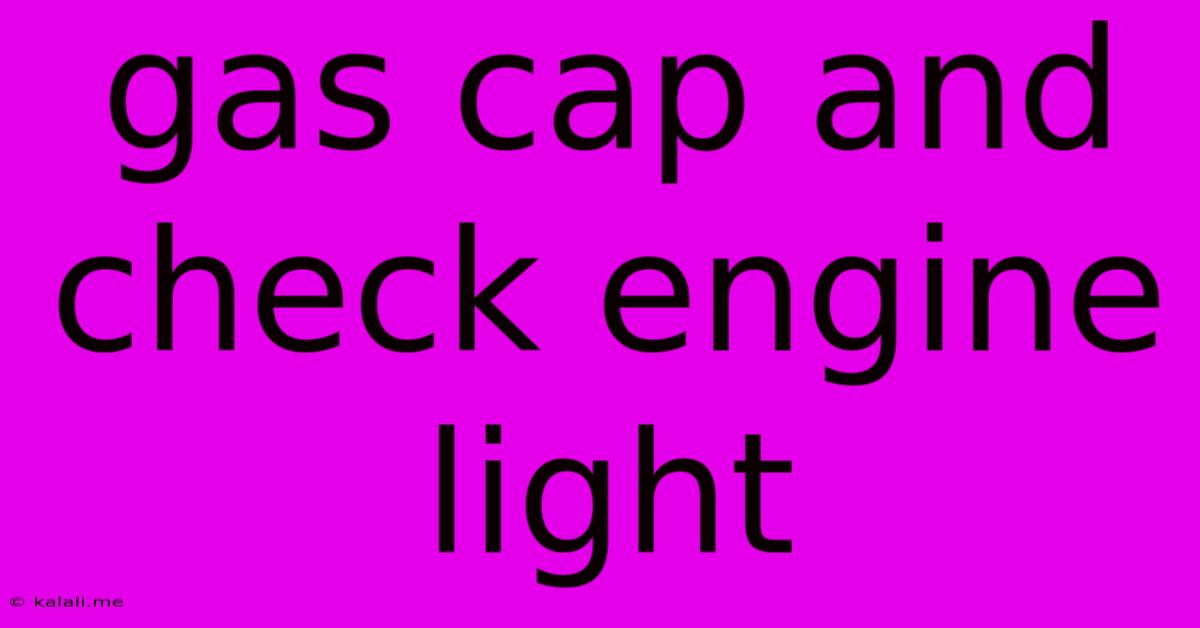Gas Cap And Check Engine Light
Kalali
Jun 05, 2025 · 3 min read

Table of Contents
Gas Cap and Check Engine Light: A Common Culprit You Can Fix Yourself
A flashing or illuminated check engine light can be a source of stress for any car owner. While it often signals a serious mechanical issue, sometimes the culprit is surprisingly simple: a loose or faulty gas cap. This article will explore the connection between your gas cap and that dreaded check engine light, explaining why it happens and how to resolve the problem. Understanding this common issue can save you time, money, and a trip to the mechanic.
Why Your Gas Cap Can Trigger the Check Engine Light
Your car's emission control system is designed to minimize harmful pollutants released into the atmosphere. A critical component of this system is the evaporative emission control system (EVAP). The EVAP system prevents fuel vapors from escaping into the atmosphere. Your gas cap plays a vital role in this system by creating an airtight seal on your fuel tank.
When your gas cap is loose, damaged, or missing, fuel vapors can leak out. The onboard diagnostic system (OBD-II) in your car detects this leak and illuminates the check engine light as a warning. This is usually indicated by a specific trouble code related to the EVAP system. While seemingly minor, this leak contributes to air pollution and can impact your vehicle's fuel efficiency.
Symptoms of a Gas Cap-Related Check Engine Light
The check engine light is the primary indicator. However, other symptoms may accompany a faulty gas cap, although these are less common:
- Check Engine Light flashing: A flashing light usually indicates a more serious problem, but a loose gas cap can cause it to flash in some vehicles.
- Strong fuel odor: A noticeable smell of gasoline around your car could signify a leak, though this isn't always connected directly to the gas cap.
- No noticeable symptoms: Often, the only sign is the illuminated check engine light.
Troubleshooting and Fixing the Problem
The good news is that fixing a gas cap-related check engine light is usually straightforward and inexpensive:
- Check your gas cap: Ensure the gas cap is properly secured and tightened. A simple twist might be all it takes.
- Inspect your gas cap: Look for any damage, cracks, or wear. If the gas cap is damaged, it needs replacement. A new gas cap is relatively inexpensive and readily available at auto parts stores.
- Tighten the gas cap: After securing the cap, drive your car for a short distance (around 100 miles). The check engine light should turn off automatically after a few driving cycles if the problem was solely the gas cap. If the light remains illuminated, you'll need further diagnostic steps.
- Clear the code (Optional): Some vehicles allow you to clear the check engine light using an OBD-II scanner. While this doesn't fix the underlying issue, it will turn off the light temporarily, allowing you to see if the problem reoccurs. However, ensure the gas cap issue is resolved before clearing the code.
When to See a Mechanic
If tightening or replacing the gas cap doesn't resolve the check engine light, there's likely a more serious problem with your EVAP system that requires professional attention. A mechanic can diagnose the issue using a sophisticated OBD-II scanner and repair or replace the faulty components.
Prevention is Key
To prevent future gas cap-related issues:
- Always tighten the gas cap securely after refueling. This is the single most effective preventative measure.
- Regularly inspect your gas cap for damage. Replace it if necessary.
In conclusion, while a check engine light can be alarming, understanding the potential connection to your gas cap can often lead to a quick and easy fix. By following the troubleshooting steps outlined above, you can save time and money, resolving a common car problem yourself. However, always remember to seek professional help if the problem persists after addressing the gas cap.
Latest Posts
Latest Posts
-
How To Replace Heating Element In Water Heater
Jun 07, 2025
-
No Available Modular Metadata For Modular Package
Jun 07, 2025
-
Terrible Quality On Hdmi Cable Macbook
Jun 07, 2025
-
What Causes A Air Conditioner To Freeze Up
Jun 07, 2025
-
The World You Grew Up In No Longer Exists
Jun 07, 2025
Related Post
Thank you for visiting our website which covers about Gas Cap And Check Engine Light . We hope the information provided has been useful to you. Feel free to contact us if you have any questions or need further assistance. See you next time and don't miss to bookmark.